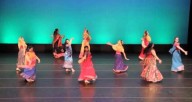UPDATE: The new seechicagodance.com will launch March 31st. Click here to learn more.
Mandala South Asian Performing Arts presents “The Choreographer’s Showcase,” featuring the voices of three distinct artists.
As I walk into the lobby of the Chicago History Museum, I hear bells echoing between the high ceilings and marble floor of the lobby. Young girls dressed in brightly colored saris and wearing jingling, ankle-bound ghungroos darted in and out of the crowd assembled to see The Choreographer Showcase presented last Sunday by Mandala South Asian Performing Arts in the McCormick Theater. The showcase featured works of dance by artists Ashwaty Chennet and Shalaka Kulkarni, and an acoustic musical interlude by Krissy Bermark. I followed the sounds of giggling and jingling into the long, square McCormick Theatre as the lights began to dim.
The program began with “Alight,” a new work directed by Ashwaty Chennet that combines the aesthetics of Bharatanatyam and modern dance. The work features choreography by Chennet and dancers Misha Talapatra and Tuli Bera accompanied by a pastoral soundscape of chirping birds and running water by PM Tummala.
“Alight” is the story of an artist being pulled in opposing directions by forces both external and from within. The piece opens with The Artist (Chennet), dressed in a loose-fitting beige blouse and bell-shaped tan pants, standing centerstage in a dim pool of light, hunched over, legs crossed. Her back leg nervously taps on the floor while her hands claw at the air, like a mountain climber trying to find a new handhold after losing their grip. After wandering for a little while, she comes across The Creative Self (Bera), a Puckish spirit in an orange robe and navy-blue pants. Bera, like a sculptor molding clay on a spinning pottery wheel, uses her hands to shape and cajole Chennet, who limbs retract, extend and twirl in a frenzy. They become entangled, creating abstract dual shapes like whisked oil and water.
They are tempered only by an elemental force, a goddess, played by Talapatra in a blue robe lined with white embroidery, who takes them both under her wing, leading them in an exercise that has all three simultaneously digging syncopated rhythms into floor with their heels while swirling their arms overhead. Chennet’s lyrical direction and the expressiveness of the choreography made “Alight” feel like a familiar parable that I have always known, even though I was hearing the story for the first time.
Multi-instrumentalist and vocalist Krissy Bergmark provides a palette -cleansing musical interlude combing polyrhythmic improvisations using both hands on two differently pitched tablas, over which Bergmark floats light and airy vocalizations of Appalachian folk melodies. Bergmark does a cover of “I’ve Endured” by Ola Belle Reed. What is striking is how good these blues-inspired melodies sound over the constantly changing rhythmic texture played by Bergmark; on the larger tabla, her left hand plays a syncopated 3-count (dwoom, dwoom - dwoom) while the right hand tickles out speedy 16th note triplets (ticka-tacka-tocka, ticka-tacka-tocka), then suddenly plunging into to a heavy 3/2 counter rhythm that has the rhythmic effect of slowing down time —like the musical equivalent of bullet-time from “The Matrix” movies.
In a perfect world, Bergmark would have been accompanying the dancers—the absence of live music for the dance pieces was a little underwhelming—but if there was an itch produced by the use of canned music, Bergmark scratches it.
Closing the program is “Nayra’s Dream,” a solo work choreographed and performed by Shalaka Kulkani, whose style is a juxtaposition of fluid Bharatanatyam (Southern Indian) and rhythmically more syncopated Kathak (Northern Indian) dance forms. The dancing is set to music by Ludovico Einaudi, which includes overlayed voices reading text by Maya Angelou, Sujatha Bhatt and Kulkani, and visual media by Justin Botz projected on the back curtain.
The piece begins with Kulkani —wearing a shiny, sea-green, jewel-embedded top over an orange skirt with gold-lined layers of fabric resembling flower petals—in a low crouch, balancing on the balls of her feet, knees wide apart. Her gaze draws attention to the quickly shifting mudras in her hands, an impressive display of technique. A voice repeats, “I rise… I rise…” on a loop while montage-like projections are displayed on the dark curtain in the background. These images are obscured by the makeshift screen’s dark color and rippled texture, but there are moments when it is effective, like when Kulkani perfectly times a loose, extended undulation of the arms with the emergence of a rolling whiff of smoke and dust, which appears to emanate from the dancer herself.
Another moment of media/dance cohesion happens when Kulkani’s blade-like arms etch squiggly lines in the air that then magically appear as rolling squiggles behind her. Despite the technical limitations and dim lighting, Kulkani’s movements are noticeably sharp and detailed. Compared to Chennet’s straightforward narrative approach, the abstract nature of Kulkani’s “Naya’s Dream” is a nice balance and allows the audience members to create their own story.
The hourlong program was over in a flash. The three performances were unique and well-paced. The name “Choreographer’s Showcase” suited the mediocre level of production. The lighting was sparse, uninteresting and at times unfocused. But, due to the ethereal nature of the works, the dimness gave the subjects on stage a dreamlike appearance, distracting only slightly. While there were no bells and whistles—well, there were some bells—the focus on this program was on the art itself, which shows in the high quality produced by these three distinct artists.


